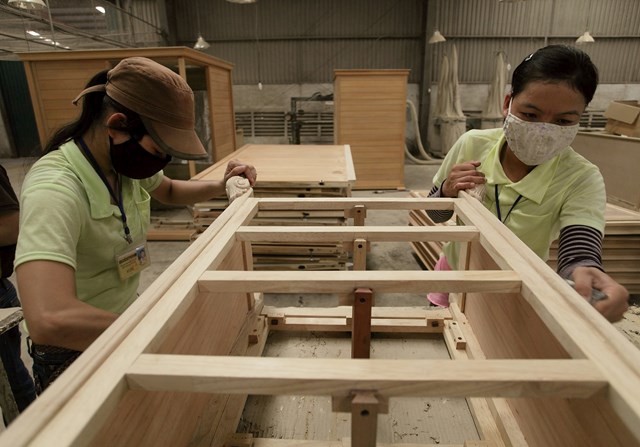 Economy
Economy


|
| Việt Nam's export value of timber and wooden products stood at $7.3 billion in the first eight months of this year. — Photo daidoanket.vn |
HÀ NỘI — Experts believe Việt Nam this year will reach its export target for timber and wooden products at US$12 billion, despite the impact of the COVID-19 pandemic.
According to the Import and Export Department under the Ministry of Industry and Trade (MoIT), the export value of timber and wood products in August was estimated at $1.15 billion, up 21.7 per cent year on year. Of which, the export value of wooden products was $924 million, up 35.2 per cent compared to August 2019.
In the first eight months of this year, the export value of timber and wooden products stood at $7.3 billion, up 9.6 per cent over the same period in 2019, including $5.45 billion from wooden product exports, up 14 per cent.
Tô Ngọc Ngời, general director of the Vinafor Saigon Company, said the country gained growth in the export of timber and wooden products in the first eight months and this positive situation is forecasted to continue until year end. Therefore, the domestic wood industry expects to reach its export target of $12 billion this year.
The pandemic continues to pose problems, but at present, some countries have ended social distancing measures. Therefore, from mid-July, the company has received many new orders, he said. The domestic supply of raw materials has met demand for those new orders instead of material imported from countries that are still implementing social distancing.
To achieve the export target of $12 billion, Việt Nam's wood industry must undergo many changes, including the Handicraft and Wood Industry Association of HCM City (HAWA)’s initiative of developing an online trading platform to connect local wood and furniture businesses with foreign partners, reported dangcongsan.vn, online newspaper of the Việt Nam Communist Party.
In the last two quarters of this year, Việt Nam's timber and wooden product exports are expected to record growth thanks to the renovation efforts of businesses, support from the Ministry of Agriculture and Rural Development and signs of recovery in some major markets.
To increase the export value of wooden products, the Việt Nam Administration of Forestry said that local companies need to focus on maintaining growth in five high export markets, including the US, Japan, China, the EU, and South Korea. At the same time, they should expand market shares in a number of potential markets through efficient trade promotion programmes.
They should promote use of advanced and environmentally friendly technologies and automatic equipment systems in processing wooden products to improve quality and save raw materials. They also need to comply with regulations on product origin.
According to the General Department of Forestry, Việt Nam still has many opportunities to expand export markets and increase export value for timber and wooden products. The world's furniture and wooden product market is large with a value of about $430 billion, including $150 billion from furniture products. Meanwhile, Việt Nam’s furniture products at present only account for about 6 per cent of the global market share.
Besides traditional markets with high export value such as the United States, Japan, China, EU, and South Korea, some other potential markets also bring more opportunities for Việt Nam to promote furniture exports, like Canada, Russia and India.
The Voluntary Partnership Agreement on Forest Law Enforcement, Governance and Trade (VPA/FLEGT) between Việt Nam and the EU effective from June 1, 2019 helps local businesses to improve competitiveness for wooden products exported to the EU, according to the general department.
The US market's demand for wood products from other countries, including Việt Nam, is likely to increase because high import tax imposed on Chinese products has reduced furniture imported from this market.
In addition, Việt Nam has ratified free trade agreements with many partners such as the EU, Japan, Chile and South Korea and it is implementing those FTAs so Việt Nam’s many goods enjoy reductions or elimination in import duties. That would create a competitive advantage for export goods of Việt Nam to those markets.
In addition, the Government, ministries, sectors and localities are implementing many solutions to continuously improve the investment and business environment for businesses processing export wooden products, including reduction of administrative procedures. — VNS